| Listing 1 - 10 of 13 | << page >> |
Sort by
|
Book
ISBN: 3031410939 3031410920 Year: 2023 Publisher: Cham : Springer Nature Switzerland : Imprint: Springer,
Abstract | Keywords | Export | Availability | Bookmark
 Loading...
Loading...Choose an application
- Reference Manager
- EndNote
- RefWorks (Direct export to RefWorks)
This book provides a comprehensive overview of positron profilometry, specifically focusing on the analysis of defect depth distribution in materials. Positron profilometry plays a crucial role in understanding and characterizing defects in a wide range of materials, including metals, semiconductors, polymers, and ceramics. By analyzing the depth distribution of defects, researchers can gain insights into various material properties, such as crystal structure, defect density, and diffusion behavior. The author's extensive research spanning a period of two decades has primarily centered on subsurface zones. These regions, located beneath the surface and subjected to various surface processes, play a crucial role in generating defect distributions. Three experimental techniques and their data analysis are described in detail: a variable-energy positron beam (VEP) called sometimes a slow positron beam, a technique called implantation profile depth scanning (DSIP), and a sequential etching (SET) technique. The usability of these techniques is illustrated by many examples of measurements by the author and others.
Materials --- Antimatter. --- Condensed matter. --- Building materials. --- Materials Characterization Technique. --- Matter-Antimatter Interactions. --- Condensed Matter Physics. --- Structural Materials. --- Analysis.
Book
ISBN: 0750320214 9780750320214 Year: 2018 Publisher: Bristol [England] (Temple Circus, Temple Way, Bristol BS1 6HG, UK) : IOP Publishing,
Abstract | Keywords | Export | Availability | Bookmark
 Loading...
Loading...Choose an application
- Reference Manager
- EndNote
- RefWorks (Direct export to RefWorks)
Why does our universe consist purely of matter, even though the same amount of antimatter and matter should have been produced at the moment of the Big Bang 13.8 billion years ago? One of the most potentially fruitful approaches to address the mystery is to study the properties of antihydrogen and antiprotons. Because they are both stable, we can in principle make measurement precision as high as we need to see differences between these antimatter systems and their matter counterparts, i.e. hydrogen and protons. This is the goal of cold antihydrogen research. To study a fundamental symmetry--charge, parity, and time reversal (CPT) symmetry--which should lead to identical spectra in hydrogen and antihydrogen, as well as the weak equivalence principle (WEP), cold antihydrogen research seeks any discrepancies between matter and antimatter, which might also offer clues to the missing antimatter mystery. Precision tests of CPT have already been carried out in other systems, but antihydrogen spectroscopy offers the hope of reaching even higher sensitivity to violations of CPT. Meanwhile, utilizing the Earth and antihydrogen atoms as an experimental system, the WEP predicts a gravitational interaction between matter and antimatter that is identical to that between any two matter objects. The WEP has been tested to very high precision for a range of material compositions, but no such precision test using antimatter has yet been carried out, offering hope of a telltale inconsistency between matter and antimatter. In this Discovery book, we invite you to visit the frontiers of cold antimatter research, focusing on new technologies to form beams of antihydrogen atoms and antihydrogen ions, and new ways of interrogating the properties of antimatter.
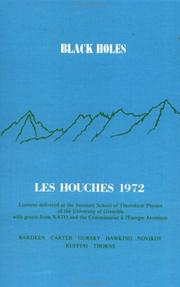
ISBN: 0677156103 9780677156101 Year: 1973 Volume: 1972 Publisher: New-York (N.Y.): Gordon and Breach,
Abstract | Keywords | Export | Availability | Bookmark
 Loading...
Loading...Choose an application
- Reference Manager
- EndNote
- RefWorks (Direct export to RefWorks)
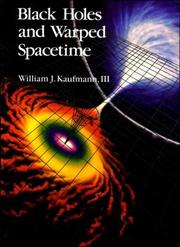
ISBN: 0716711524 0716711532 Year: 1979 Publisher: San Francisco : W. H. Freeman,
Abstract | Keywords | Export | Availability | Bookmark
 Loading...
Loading...Choose an application
- Reference Manager
- EndNote
- RefWorks (Direct export to RefWorks)
Space and time --- Espace et temps --- 524.88 --- 524 --- Special hypotheses. Black holes. Antimatter --- Stars. Stellar systems. The Universe --- 524 Stars. Stellar systems. The Universe --- 524.88 Special hypotheses. Black holes. Antimatter --- Space of more than three dimensions --- Space-time --- Space-time continuum --- Space-times --- Spacetime --- Time and space --- Fourth dimension --- Infinite --- Metaphysics --- Philosophy --- Space sciences --- Time --- Beginning --- Hyperspace --- Relativity (Physics) --- Stars
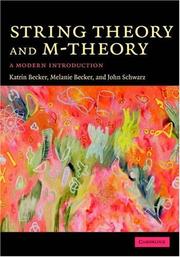
ISBN: 9780521860697 0521860695 9780511816086 9780511648830 0511648839 0511256531 9780511256530 0511255969 9780511255960 0511254865 9780511254864 0511816081 0511644825 9780511644825 9786612395154 661239515X 1282395157 9781282395152 1139637363 9781139637367 0511568983 9780511568985 110716768X Year: 2007 Publisher: Cambridge: Cambridge university press,
Abstract | Keywords | Export | Availability | Bookmark
 Loading...
Loading...Choose an application
- Reference Manager
- EndNote
- RefWorks (Direct export to RefWorks)
String theory is one of the most exciting and challenging areas of modern theoretical physics. This book guides the reader from the basics of string theory to recent developments. It introduces the basics of perturbative string theory, world-sheet supersymmetry, space-time supersymmetry, conformal field theory and the heterotic string, before describing modern developments, including D-branes, string dualities and M-theory. It then covers string geometry and flux compactifications, applications to cosmology and particle physics, black holes in string theory and M-theory, and the microscopic origin of black-hole entropy. It concludes with Matrix theory, the AdS/CFT duality and its generalizations. This book is ideal for graduate students and researchers in modern string theory, and will make an excellent textbook for a one-year course on string theory. It contains over 120 exercises with solutions, and over 200 homework problems with solutions available on a password protected website for lecturers at www.cambridge.org/9780521860697.
String models --- Modèles des cordes vibrantes (Physique nucléaire) --- String models. --- 524.88 --- Special hypotheses. Black holes. Antimatter --- 524.88 Special hypotheses. Black holes. Antimatter --- Modèles des cordes vibrantes (Physique nucléaire) --- Models, String --- String theory --- Nuclear reactions --- String models - Problems, exercises, etc.
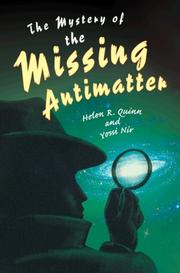
ISBN: 9780691133096 0691133093 0691163936 9786612531675 1282531670 1400835712 9780691163932 9781400835713 Year: 2014 Publisher: Princeton, N. J.: Princeton university press,
Abstract | Keywords | Export | Availability | Bookmark
 Loading...
Loading...Choose an application
- Reference Manager
- EndNote
- RefWorks (Direct export to RefWorks)
In the first fractions of a second after the Big Bang lingers a question at the heart of our very existence: why does the universe contain matter but almost no antimatter? The laws of physics tell us that equal amounts of matter and antimatter were produced in the early universe-but then something odd happened. Matter won out over antimatter; had it not, the universe today would be dark and barren.But how and when did this occur? In The Mystery of the Missing Antimatter, Helen Quinn and Yossi Nir guide readers into the very heart of this mystery-and along the way offer an exhilarating grand tour of cutting-edge physics.
Antimatter --- Particles (Nuclear physics) --- Cosmology --- Antimatière --- Particules (Physique nucléaire) --- Cosmologie --- Popular works. --- Ouvrages de vulgarisation --- Elementary particles (Physics) --- High energy physics --- Nuclear particles --- Nucleons --- Nuclear physics --- Matter --- Properties --- Antimatter - Popular works --- Particles (Nuclear physics) - Popular works --- Cosmology - Popular works
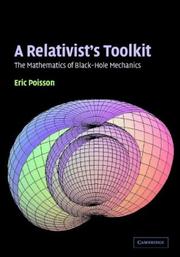
ISBN: 9780511606601 9780521830911 9780521537803 9780511648199 0511648197 0511606605 0521830915 0511194617 9780511194610 9780511193873 0511193874 1107148316 9786612394836 1282394835 0511644418 0511566611 0521537800 9781107148314 6612394838 9781282394834 9780511644412 9780511566615 Year: 2004 Publisher: Cambridge, UK ; New York : Cambridge University Press,
Abstract | Keywords | Export | Availability | Bookmark
 Loading...
Loading...Choose an application
- Reference Manager
- EndNote
- RefWorks (Direct export to RefWorks)
This 2004 textbook fills a gap in the literature on general relativity by providing the advanced student with practical tools for the computation of many physically interesting quantities. The context is provided by the mathematical theory of black holes, one of the most elegant, successful, and relevant applications of general relativity. Among the topics discussed are congruencies of timelike and null geodesics, the embedding of spacelike, timelike and null hypersurfaces in spacetime, and the Lagrangian and Hamiltonian formulations of general relativity. Although the book is self-contained, it is not meant to serve as an introduction to general relativity. Instead, it is meant to help the reader acquire advanced skills and become a competent researcher in relativity and gravitational physics. The primary readership consists of graduate students in gravitational physics. It will also be a useful reference for more seasoned researchers working in this field.
Black holes (Astronomy) --- General relativity (Physics) --- Mathematical physics --- 524.88 --- 524.88 Special hypotheses. Black holes. Antimatter --- Special hypotheses. Black holes. Antimatter --- Physical mathematics --- Physics --- Relativistic theory of gravitation --- Relativity theory, General --- Gravitation --- Relativity (Physics) --- Frozen stars --- Compact objects (Astronomy) --- Gravitational collapse --- Stars --- Mathematics --- Mathematical physics. --- Mathematics. --- General relativity (Physics).
Book
ISBN: 3030677915 3030677907 9783030677916 Year: 2021 Publisher: Cham, Switzerland : Springer,
Abstract | Keywords | Export | Availability | Bookmark
 Loading...
Loading...Choose an application
- Reference Manager
- EndNote
- RefWorks (Direct export to RefWorks)
Antimatter is one of the most fascinating aspects of Particle Physics, and matter-antimatter annihilation the most energetic process in the universe. If they existed, everyday objects made of antimatter would look exactly like those made of ordinary matter, as would antimatter stars. We live surrounded by antimatter, since showers of matter and antimatter particles fall incessantly on the Earth's surface, some of them penetrating our buildings. Furthermore, many things around us - bananas, for example - actually emit antielectrons. This book first introduces the essentials of particle physics and the nature of particles and antiparticles. It describes the discovery of antimatter particles and explains how they are produced, where they are found, and how antistars could be spotted; it also introduces cosmic rays, particle accelerators, dark matter, dark energy and nuclear reactions in stars. The enigma of the matter-antimatter asymmetry in the Universe is discussed as are the very real applications of antimatter in hospitals, in industry and in cutting-edge research and technology, Non-specialist readers will find here a wealth of fascinating and accessible information to deepen their appreciation of antimatter.
Antimatter. --- Particles (Nuclear physics) --- Quantum field theory. --- Relativistic quantum field theory --- Field theory (Physics) --- Quantum theory --- Relativity (Physics) --- Elementary particles (Physics) --- High energy physics --- Nuclear particles --- Nucleons --- Nuclear physics --- Matter --- Properties
Book
Abstract | Keywords | Export | Availability | Bookmark
 Loading...
Loading...Choose an application
- Reference Manager
- EndNote
- RefWorks (Direct export to RefWorks)
Particles (Nuclear physics) --- Particles. --- Antimatter. --- Supersymmetry. --- Symmetry (Physics) --- Neutrinos. --- Large Hadron Collider (France and Switzerland) --- Particules (physique nucléaire) --- Particules (matière) --- Antimatière. --- Supersymétrie. --- Symétrie (physique) --- Grand collisionneur de hadrons.
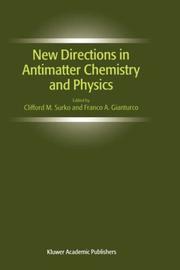
ISBN: 1280200995 9786610200993 0306476134 0792371526 Year: 2001 Publisher: Dordrecht, Netherlands : Kluwer Academic Publishers,
Abstract | Keywords | Export | Availability | Bookmark
 Loading...
Loading...Choose an application
- Reference Manager
- EndNote
- RefWorks (Direct export to RefWorks)
This volume is the outgrowth of a workshop held in October, 2000 at the Institute for Theoretical Atomic and Molecular Physics at the Harvard- Smithsonian Center for Astrophysics in Cambridge, MA. The aim of this book (similar in theme to the workshop) is to present an overview of new directions in antimatter physics and chemistry research. The emphasis is on positron and positronium interactions both with themselves and with ordinary matter. The timeliness of this subject comes from several considerations. New concepts for intense positron sources and the development of positron accumulators and trap-based positron beams provide qualitatively new experimental capabilities. On the theoretical side, the ability to model complex systems and complex processes has increased dramatically in recent years, due in part to progress in computational physics. There are presently an intriguing variety of phenomena that await theoretical explanation. It is virtually assured that the new experimental capabilities in this area will lead to a rapid expansion of this list. This book is organized into four sections: The first section discusses potential new experimental capabilities and the uses and the progress that might be made with them. The second section discusses topics involving antihydrogen and many-body phenomena, including Bose condensation of positronium atoms and positron interactions with materials. The final two sections treat a range of topics involving positron and positronium interactions with atoms and molecules.
Antimatter. --- Antinucleons. --- Chemistry, Physical organic. --- Atomic, Molecular, Optical and Plasma Physics. --- Physical Chemistry. --- Condensed Matter Physics. --- Chemistry, Physical organic --- Chemistry, Organic --- Chemistry, Physical and theoretical --- Atoms. --- Physics. --- Physical chemistry. --- Condensed matter. --- Condensed materials --- Condensed media --- Condensed phase --- Materials, Condensed --- Media, Condensed --- Phase, Condensed --- Liquids --- Matter --- Solids --- Chemistry, Theoretical --- Physical chemistry --- Theoretical chemistry --- Chemistry --- Natural philosophy --- Philosophy, Natural --- Physical sciences --- Dynamics --- Stereochemistry --- Constitution --- Properties
| Listing 1 - 10 of 13 | << page >> |
Sort by
|

 Search
Search Feedback
Feedback About UniCat
About UniCat  Help
Help News
News